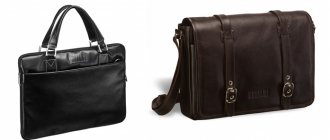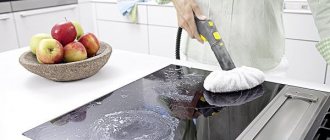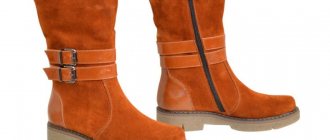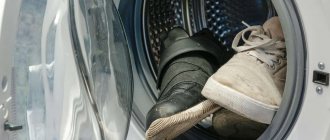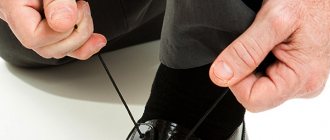It would seem that I also have a question - How to care for rubber boots? It's rubber! Wash it and that’s it, especially if it’s nondescript, plain shoes). Of course, you can do this if you don’t value it or you want it to lose weight quickly so you can buy new, prettier ones without a twinge of conscience). And if they are already like this: you chose them correctly, they are comfortable, beautiful and you never want to part with them? In order for your boots to serve you faithfully for many years, it is better to read this article and know what to do so as not to spoil anything ahead of time.
Author of the article: Hostess.
My name is Natalya and I have been managing my home professionally for more than 15 years. Saving my extended family's favorite things; I protect our house from fleas, midges, bloodsuckers and other rodents; I find faithful electronic assistants in household chores. And I am happy to pass on this entire experience to you)
Do you also want to become a Hostess on our blog? There's enough room for everyone! Just write to us via the “contact” form)
Can rubber boots be washed in a washing machine?
In short - it is possible. As long as these conditions are met, boots in the “washing machine” are in no danger:
- should be placed in the drum with the soles facing up;
- temperature - no higher than 50 °C;
- mode - for shoes (when there is no such thing - delicate);
- spinning and drying are disabled.
For boots with a fabric interior and fur, it is better not to use powdered detergents. They are difficult to wash out and can cause skin irritation. “Liquid powders”, gels, liquid soaps and other soft preparations are used freely.
Self-removal of damage (stains, punctures)
I washed it and there is no stain
Impregnation for rubber shoes eliminates salt stains. Other types of dirt can be removed with a regular eraser or a cloth soaked in soapy water. By the way, you can also use an eraser to clean the light rubber soles of sneakers and sneakers.
Alcohol can deal with difficult stains. You cannot use acetone, gasoline or kerosene for cleaning - the material will be damaged.
Children's boots Nordman
How to wash stubborn dirt from rubber boots
| Way | Description |
| A mixture of lemon juice and soda | Mix in approximately equal proportions and use as described in the article above. |
| Vegetable oil | Sunflower and olive oils are good at scrubbing away old dirt. But before use, it is better to find out what the boots are made of. The composition is dominated by PVC - fat can disrupt the structure of the material and greatly reduce the service life of boots. |
| Solvents | White spirit (to a lesser extent, acetone) is used when nothing else helps. The product is effective, but you must be prepared for the risk of color fading. Shoe paint will help restore it. |
Shoe storage
To store seasonal shoes without consequences, you can use cardboard boxes, organizers or special containers.
When choosing, be sure to look for the presence of ventilation holes, absence of odor and sufficient volume. Organizer
The device is distinguished by the presence of many compartments. They can store up to several pairs of shoes. The organizer also provides excellent air circulation.
Box
Boxes are convenient and practical for storing any shoes. The only downside is that you won’t see what product is there. However, you can sign. Modern models have a viewing window. You can buy it online.
Containers
A plastic container has a number of advantages over a classic cardboard box. This product has sufficient strength and transparency.
Make sure you have containers or boxes for each pair of shoes in advance. In this case, it is unacceptable to put sneakers, demi-season shoes, going out shoes and work boots “in a pile.” Otherwise, scratches and other damage will appear on the surface of the products.
How to remove yellowed stains
| Way | Description |
| "Pemolux" (and other powder cleaning agents) | They cope well with yellowness, which nothing else “takes away”. But a significant disadvantage is that the powder can leave scratches on the rubber. To reduce the risk, a soft dish sponge is used in processing. |
| 9% vinegar | It is added to the detergent during machine washing. 2 tbsp is enough. l. for a pair of boots. |
| Dishwashing detergent | Liquid detergent is dissolved in warm water and the boots are soaked for 2-3 hours. After 1 hour, you can wipe off the stains with a sponge. |
Simple cleansing between socks (in season).
First you need to get rid of the main dirt , especially if you kneaded it with boots somewhere in an earthy place. Ideally, it is possible to wash them under the pressure of a stream from a hose in the yard.
If not, pour a deep basin or bucket of warm water and scrub with a sponge manually.
- ✦ It is better to immediately remove large pieces of stuck dirt with your hands and throw them in the trash so that they do not clog the drain.
- ✦ Try not to let water get inside or on the zipper if your boots have them.
- ✦ To avoid clogging the drain, pour dirty water into the toilet (if you wash at home), and not into the bathtub or sink.
- ✦ Change the water more often to avoid messy streaks.
- ✦ Carry out the procedure several times until the rubber is clean.
- ✦ Afterwards, wipe the boots with a soft, dry cloth and leave to dry.
This is a shortcut if you need to wash and wear again soon.
If you need to clean them completely (to put them away for long-term storage, for example), then continue.
Sometimes there just isn't enough water. Well, then add dishwashing liquid or other soapy detergent to your wash water or directly to the sponge.
This is how they looked before washing.
Washed rubber boots with a sponge and soap
Sometimes it is recommended to use powder products like Pemolux, but remember that they can scratch your shoes. Use the non-hard side of the sponge as much , it will still be softer, but forget about very hard brushes and sponges.
⚠️ Important! Do not use any types of oils, gasoline, kerosene, or other solvents for cleaning - they can harm your shoes , especially if you are not sure what type of rubber boots you have. Using vegetable oil, you can only clean rubber shoes made of rubber (not light-colored ones!), but this can greatly harm PVC.
Be sure to wash the insoles by hand or in a washing machine with vinegar and dry them thoroughly so that you do not notice an unpleasant musty odor later.
How to clean the inside of boots
The inside of the boots is cleaned to remove the smell of sweat. There is almost no dirt inside, but sweat is easy.
Rubber does not “breathe”, and winter socks also do their job. Therefore, the following methods are used:
- washing (hand and machine);
- wet cleaning with liquid detergent (usually using a toothbrush);
- rubbing with potassium permanganate and peroxide (cotton swabs are moistened in the selected preparation or mixture thereof);
- wet cleaning (peroxide or ammonia is poured directly inside).
But the best thing is dry powder (sea salt, talc, powdered activated carbon). This is the safest method, because it will definitely not damage the fabric lining of the boots. The product is simply poured inside and left inside, and shaken out in the morning.
How to dry boots after cleaning
| Type of boots | Drying |
| Unlined (usually made of EVA material) | Wipe with a dry cloth outside and inside to absorb excess moisture. Then it is dried in a ventilated area. |
| With fabric inside | Crumpled paper is stuffed inside to quickly “pull” moisture out of the fabric. Leave at room temperature until completely dry. You can do it without paper - it will just take longer. |
| With fur | If the fur is removed, it is taken out and dried on a radiator. Fixed fur - blot it with a dry cloth or paper (but do not leave it inside), but dry it indoors. Ventilation is desirable. |
There are things you shouldn't do:
- Dry rubber by heating. A battery, an electric dryer, a hair dryer - everything harms both rubber and polymers. The temperature deteriorates the shape of the boots.
- Leave in a closed cabinet (and put in a box). If the air supply is limited, a strong rubber smell appears in the boots.
- Leave the insoles inside. If they are taken out, you should always clean them up.
- Wear wet. This is harmful to both health (you can catch a cold) and the material (especially if the inside is fabric or fur).
Storing casual shoes
- In most cases, people do not attach importance to the daily storage of shoes, but in vain. Not only do you wear boots or sneakers every day, but they also lack proper care. The service life of the products directly depends on this.
- Before placing your shoes in the hallway, dry and clean them. In dry weather this will not take much time, but during rain or slush such manipulations are simply necessary.
- If you don’t have the energy to clean, but your shoes are wet, fill them with crumpled newspapers or buy a special dryer. It is inserted inside the product and dries it in a couple of hours.
- After the procedure, be sure to lubricate your shoes with emulsions, especially when it comes to leather. It doesn’t matter whether the boots are expensive or cheap, you need to take care of them.
- As for storage, choose a place with good air circulation, away from dampness and direct sunlight. Buy a special shelf or wardrobe for shoes.
- Keep your shoes loose and do not stack one pair on top of another, especially for items with dirty soles. During the cold season, do not leave wet shoes on the linoleum so that water does not accumulate under the soles.
- All products must be placed at a certain distance from each other. Traditional storage “in the hallway” is not the best option. The result is crowding, which causes a lot of inconvenience.
- Organize your storage space so that shoes have a separate place. Use shelves, hanging “pockets”, pull-out cabinets, etc. Remove shoes in a timely manner if their season is over.
- Remove the insoles and laces in advance. Get rid of debris and wipe down your shoes with any disinfectant solution. Rinse the soles of dirt, clean the shoes with a brush or rinse if necessary. Dry, lubricate with cream taking into account the material of the product.
- There is no need to allocate separate space for storing winter or summer shoes. The main thing is to make sure that there is a box or container for each pair.
- Place newspapers in the cavity of winter shoes with fur so that the products do not lose their shape. Mothballs are also placed inside to repel moths if the inside of the shoe has fur.
- To prevent dust from settling, shoes and other types of dress shoes are placed first in covers, then in boxes. Over the knee boots and long boots should be placed in a case and hung (can be laid out) in a straightened form. No need to fold the boot.
- The storage location is chosen without sudden changes in temperature, dampness or excessive dryness. It is also necessary to check your shoes several times a season (every month) to prevent possible damage.
How to prevent dirt from appearing
| Way | Description |
| Water repellent spray | Such drugs are sold in most industrial stores. They are applied to boots according to the instructions, but usually the procedure must be repeated twice, with an interval of 20-30 minutes. Spray the spray only on dry rubber. |
| Creams, waxes and balms | Shoe care products can also be used with rubber boots. It is better to use before every walk. Fat-containing products provide the best protection. |
| Vegetable oil | Rubber boots are oiled after walking. It dries overnight, and the next day a “protective layer” appears on the boots. But oil can harm PVC boots. |
How to store rubber boots after cleaning
Like other shoes, rubber shoes are recommended to be stored clean and dry.
Basic Rules:
- temperature - from 10 °C to 25 °C (away from the heating system);
- humidity - from 40% to 60% (a closet away from the bathroom is suitable);
- do not bend;
- do not put in a box without ventilation holes;
- They recommend storing them hanging, with the sole up (but you can just put them down).
And when the “dirty season” ends, the shoes must be well ventilated before long-term storage. Better - at least 3 days in a ventilated room. This will remove the risk of mold.
Basic storage rules
- Before storing your shoes, dry them thoroughly. Otherwise, moisture will accumulate inside the product, which will lead to damage to the material, the spread of bacteria and dampness.
- Never store shoes without cleaning them first. You can wipe off the dust with a damp, then dry cloth. In case of complex stains, you need to go through all the stages of cleaning and drying, and only then put it away for safekeeping.
- In order not to meet the new season with the words “I have nothing to wear,” be sure to repair your shoes in advance. Change the heels in a timely manner, and also have the products stitched by a specialist.
- Pay due attention to choosing storage space. The closet or chest of drawers should be dry, ventilated, and dark. Avoid exposure to direct sunlight. The accumulation of moisture will contribute to the development of mold, and ultraviolet radiation will lead to loss of color.
- The issue of storing shoes made from natural and expensive materials becomes especially relevant. Such wardrobe items should not be kept near heating radiators to prevent the material from drying out.
- Make it a habit to coat your shoes with emulsions, gels, and other special products that will protect the material from cracking, tarnishing, and drying out.
- It is worth remembering the rule that says that shoes should not be folded or pressed down when stored. After a long exposure in a container or box in this state, you will not be able to cope with creases and cracks will appear.

